beetle
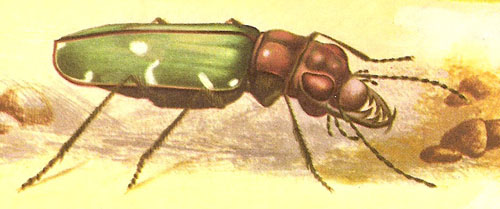
The Tiger beetle (Cicindela campestris): a fast-moving, carnivorous beetle that lives in woodland with sandy soil and feeds entirely on other insects. Its larva makes a vertical burrow, the opening of which it closes with its flat head. Any insect which walks over its head is seized and devoured.
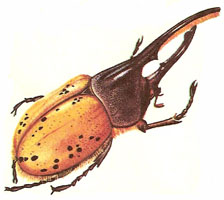
Hercules beetle (Dynastes hercules), one of the largest beetles and a native of tropical America. The fierce-looking horns are used in combat between males at mating time.
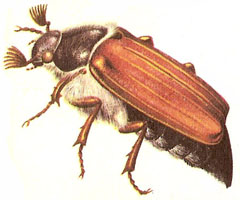
Cockchafer (Melolontha melolontha), a destructive insect unusual in being harmful both as a larva and as an adult. Its life as a larva lasts for several years and is spent underground, where it feeds on the roots of various plants, including grasses and cereals. The beetle emerges in May (it is sometimes called the "May-bug") and feeds on the foliage of trees.
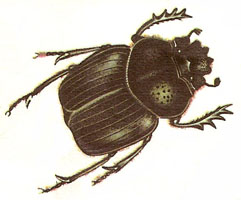
Sacred Scarab (Ateuchus sacer), regarded by the ancient Egyptians as sacred. It makes large balls of dung, which it rolls about and stores underground for its young. N.b. These illustrations are not to scale.
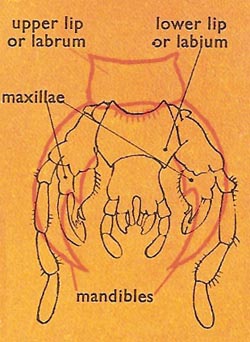
Diagram of the mouthparts of a beetle.
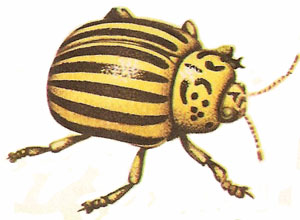
Colorado beetle (Leptinotarsa decemlineata). Like the plant it feeds on, this notorious pest of the potato is a native of North America.
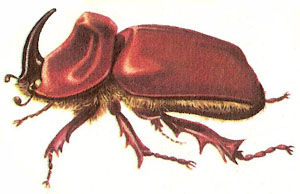
Rhinoceros beetle (Oryctes nasicornis). This beetle takes both its English and Latin names from the horn on its "nose." It is found in southern Europe and grows to about 3¾ centimeters long.
About 350,000 species of beetles are known, and many hundreds more are discovered and described every year. The order to which they belong, the Coleoptera, is by far the largest order of insects; in fact, no other order of the animal kingdom contains so many species.
Although none of them live in the sea, beetles are found in every possible habitat on land except the permanently frozen polar regions and higher mountain tops.
Main characteristics
No other group of animals vary as much in size, shape, and color as beetles do. Some are colored so that they blend in with their surroundings whereas other have bright and often iridescent colors. The long-horned or Titan beetle (Titanus giganteus) is the longest beetle in the world with a maximum length of 18 centimeters (7 inches); the Goliath beetle (Goliathus goliathus) is the heaviest of beetles, reaching weights up to 100 grams (3.5 ounces). The smallest beetle in terms of both length (0.5 millimeters) and weight (0.4 milligrams) is a species of feather-winged beetle.
Some beetles are aquatic and have developed various techniques for retaining air beneath the surface of the water. Some hold air between the abdomen and the elytra (see below); others have hairs on their ventral surface which are used to hold a layer of air against the body. Yet others, such as whirligig beetles, take a bubble of air down with them when they dive.
Anatomy
The general anatomy of beetles is uniform among all species, although some have specific organs or appendages that vary greatly in appearance and function between the many beetle families. The body of a beetle is divided into three sections: head, thorax, and abdomen.
To the thorax are attached all three pairs of legs and the wings. In most beetles there is one pair of thin, membranous wings, called allae, which, when not in use, are covered and protected by a pair of horny sheaths (also present in earwigs and some bugs), called elytra. These correspond to the fore-wings of other insects, the beetles' flying pair being the hind wings. The two elytra usually fit together like a case to protect the more delicate hindwings underneath. In order to take off, a beetle must raise its elytra before it can move its flight wings. Some species of beetles cannot fly, and in many of these the elytra are fused together to form a shield over the abdomen. However, some species have lost both the ability to fly and their elytra; the best known example of these are glow-worms. The elytra are made of the same substance, chitin, that forms the rest of the beetle's exoskeleton. The exoskeleton is made up of plates, called sclerites, which provide an armored defense.
Behind the thorax is the abdomen, and these two sections are clear to see from the beetle's ventral side. However, when viewed from above there appear to be three sections. This is because on the dorsal surface is a hard plate, called the pronotum, which appears to form a middle section. In fact, the pronotum is the front part of the thorax – the rear part of the thorax being hidden by the wings.
Beetles have compound eyes. In some species these are divided; for example, whirligig beetles have divided eyes that allow them to see both above and below the water line at the same time. A few species of beetles also have ocelli – small, simple eyes, usually situated further back on the head.
Beetles use their antennae primarily as organs to smell, but they can also use them to feel around their physical environment. The antennae vary greatly in size and design within the order Coleoptera but are often similar within families.
Beetles have multi-segmented legs, each ending in two to five segments called tarsi. Like many other insects, beetles also have claws, with one pair situated at the end of the last tarsal segment of each leg. Although beetles use their legs mainly for walking, in some species the legs are highly adapted for other purposes. In aquatic families, the legs are usually modified for swimming; other beetles have legs modified for digging, or hind legs that are modified for jumping.
To breathe, beetles obtain oxygen via a tracheal system, air entering the body through a series of openings called spiracles that are situated along the sides of the body. Beetles have a tube-like heart that is attached to the inside of the thorax on the dorsal surface, and an open circulatory system in which a substance called hemolymph is driven around the body.
Mouthparts
Insects feed in one of two ways – by chewing or by sucking. In beetles the mouthparts are of the chewing type, though they differ from human jaws in that they work from side to side, not up and down.
The diagram on the right shows the different parts that go to make up the biting and chewing apparatus of a beetle. The most powerful of them are the jaws or mandibles, which are shown in red. These are used for seizing the prey (in carnivorous beetles) and generally for holding and breaking up the food. Below and behind them is another pair of jaws, the maxillae. These carry jointed organs of touch, the palps, and are used to break up the food still more and guide it into the mouth. Above and below the mouth there is an upper and lower lip. The upper one (colored red) is a simple structure called the labrum, but the lower lip, or labium, is more complicated, and carries palps, similar to those on the maxillae.
Distribution and habitat
Beetles are found throughout the world except in the polar regions, and occur in almost every habitat except seas and oceans. Most beetles are terrestrial and live underground, in wood, or in the carcasses of animals, but there are some aquatic types. Some species of beetle even live in the nests of ants and termites, the ants providing their guests with protection from predators, while the beetles in turn eat the waste of the ants.
Reproduction and development
Beetles can display intricate courtship and mating behavior, and the use of pheromones is important in locating a mate. Many male beetles are territorial and will fiercely defend their territory from other males; in some species the mating ritual involves conflicts so intense that only the strongest and fittest individuals actually mate.
When beetles mate, the pairing is usually for a short time, but some species will stay together for several hours. During mating the sperm is transferred to the female to fertilize the egg. Eggs are usually laid in accordance with the substrate the larva will feed upon once they have hatched, and their numbers can range from a single egg to a batch of several thousand. They may simply be laid loose in the soil, or under a leaf or buried in the medium on which the larvae will feed. Parental care varies between the species; some beetles just lay their eggs and leave them, while others, such as some scarab beetles, build an underground structure complete with a supply of dung to feed and protect the youngsters.
In its life-history a beetle goes through what is known as complete metamorphosis. That is to say, during its lifetime it passes successively through four distinct forms: egg, larva, pupa, and imago (the adult form). In this, beetles are like butterflies, bees, and flies, but unlike cockroaches, grasshoppers, and bugs (Hemiptera), which grow up gradually. The larval stage is the principle feeding stage, and the larva feed voraciously when they emerge from their eggs. The larval period varies greatly between species, and can be as long as several years. Beetle larvae differ between species but can always be differentiated from other insect larvae by their hardened head which is often dark, their chewing mouth parts, and the spiracles along the sides of the body.
Beetle larvae go through several developmental stages between each molt, known as instars. In many species the larvae simply increase in size, but in others they go through a more dramatic change. Eventually, all beetle larvae pupate and a fully formed, sexually mature adult beetle emerges from the pupa. As adults, beetles have an extremely variable life span, from a few weeks in the case of some species to several years.
Diet
Beetles are able to exploit the wide diversity of food sources available in their habitats. Some are primarily carnivorous, while others are omnivores or have a highly specialized diet. They may be host specific and feed only on a certain types of plant.
Ground beetles and rove beetles, as well as many other species, are primarily carnivorous, feeding on arthropods and small prey such as earthworms and snails. Most predatory beetles feed on a variety of prey, but some have preferences or more specific prey requirements.
Decaying organic matter, including dung and dead animals, is the primary food for a large number of beetles. Scarab beetles, or dung beetles as they are also known, are among the species that feed solely or mainly on dung, and carrion beetles are an example of those that feed on decaying animals.
Predators and defense
Beetles have a wide variety of predators and a range of defense mechanisms to avoid being attacked by predators or parasitoids.
Camouflage is used by many beetles, particularly those, such as leaf beetles and weevils, that feed on wood or vegetation. Many species are colored to blend in with their background, while others have various colored scales, hairs, or a particular shape that makes them look like something inedible.
Mimicry is another form of defense that uses color and shape to fool potential predators. Many species of longhorn beetles look very similar to wasps, which helps them to avoid predators, but the beetles are totally harmless. Beetles can also combine color mimicry with behavioral mimicry, so acting like the wasps they resemble is another good defense against predators.
Some beetles, such as blister beetles, ladybugs, and lycid beetles can secrete toxic or distasteful substances to deter predators. These beetles are often brightly colored as a warning sign. The bright coloration of these beetles is often mimicked by other harmless species.
Other beetles, such as large ground beetles and longhorn beetles, can defend themselves using their strong mandibles and/or spines or horns to forcibly chase away a predator. Species such as bombardier beetles can deter predators by spraying chemicals at them from their abdomen.
Taxonomy
Beetles belong to the order Coleoptera of the class Insecta; the study of beetles is called coleopterology and people that practice this are known as coleopterists. (The names of most insect orders end in "-ptera," from the Greek pteron meaning "wing." Insects are classified largely by reference to how their wings are formed, and the word Coleoptera means "sheath-winged.") The order Coleoptera is split into four suborders; Polyphaga, Adephaga, Archostemata, and Myxophaga. Approximately 40% of all known insects, and 25% of all known animals, are beetles. About 350,000 species of beetle have been described, and new species are discovered so frequently that it has been estimated there may in the region of 1 million species of beetle in existence.
Beetles as pests
Some kinds of beetles are serious pests, not because they spread disease (as mosquitoes and do) or a nuisance to us personally but because they destroy foodstuffs, both growing and stored, and other essential materials. An example of the former is the Colorado beetle, which may devastate growing crops of potatoes by eating the green parts of the plant.
The timbers of old buildings are often threatened by the destructive burrowing of the death-watch beetle. Other beetle pests include boll weevils, flour beetles, the rose chafer, and the mountain pine beetle. On the other, some beetles, such as ladybugs (ladybirds) are important in the control of agricultural pests.
Other interesting facts


